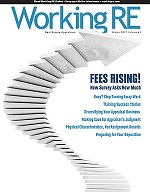 |
Services Offered this Issue
> The Appraiser Coach Podcast
|
> Join over 1,400 others. OREP/WRE’s 2017 Fee Survey!
Express Yourself
By Rachel Massey, SRA
The appraisal was good. In fact, it was really good. The logic was sound and the comparables used and analyzed were the best available. It was a complex property and the appraiser did a terrific job considering the likely buyer and what their alternatives would have been. Unfortunately, there was a problem.
The problem was that the report was bad. In fact, the report was really bad. None of the appraiser’s logic and analysis came through in writing. The complex property appraisal looked like a jumble of disconnected sales that had nothing to do with each other, let alone the subject property.
The disconnect was simple. The thought process that was involved in developing the appraisal did not make it from the appraiser’s head to the reader. While all the steps in the appraisal process had been followed and a logical result occurred, communicating the result, the last leg of the process, was weak. It was weak because the appraiser was unable to adequately communicate what was going on.
The house was unusual for the market. The market was rural and there were few comparable properties to choose from. There were sales in the area but the sales were just that, sales. The best sales were distant, older, and looked dissimilar with the exception of a couple key features. The key features in this instance were acreage properties with large pond sites, far from any town and close to areas with recreation land.
Start at Beginning
When you begin a report, think about the intended users, as well as the reviewers who will be viewing the report and step back to see if it contains sufficient information for them to be able to understand what the complexities of the situation are. Where do you start? Start at the beginning by describing what the problems are. Why is the property complex? How is it unusual? How many sales are there in the competitive market over the past year? How about two years? What is the competitive market? What would drive the buyer to consider this property and what would their alternatives logically be?
Had the appraiser laid out the problems unique to this property at the start of the narrative, the logic would follow that the client should not expect a pretty report. If the property was rural and unique and the market from which the likely buyer would consider properties broad, then say it. Spell it out so that the client knows what to expect. If the typical buyer for this property would only consider acreage properties with large pond sites, and eclectic style houses that were secluded from all neighbors, then perhaps the market includes properties thirty miles apart.
Convince the client that this is the case. If the typical buyer is a horse enthusiast who wants to be able to take their horse out for trail riding, then the likelihood is that they want to be within a short ride of the horse trails. Talk about it. These are very real considerations for many buyers and may be the overarching drivers as to which properties get considered.
(story continues below)

(story continues)
Even on complex properties, there are usually sales that can be located, and those sales are either superior, inferior, or equal to the subject property. If the appraiser steps back and looks at the bigger picture of these sales and logically details why one is better than the subject and one not as good, without any adjustment at all, the appraiser can lay out a logical value range. Watch almost any house hunting show on television and you will see this is very much what buyers do. If buyers do this and appraisers try to reflect the actions of the market, this kind of logic can help present an answer to a difficult appraisal assignment. Even with very imperfect sales data, we can still tell the story of what makes the property unusual and how the sales we choose compete and rank in comparison. From a logical standpoint, simple bracketing with inferior and superior properties can help convince our client that the property is worth more than X and less than Z, with the telling of the “why” being up to us.
Remember that no matter how good the appraisal is in our heads, if we don’t communicate it in the report, our client may well think we have presented nothing more than a jumble of sales. It is up to us to tie everything together into a cogent and compelling story and convince our client that our value opinion is sound. After all, that is what they are paying us for.
> How are Fees in Your Area? Weigh in on OREP / Working RE’s 2017 Fee Survey.
Click here to take 2017 Fee Survey!
> New Two-Part Webinar!
Condition Adjustments and Cost Approach
Part 1: February 21, 10 – 11:30 a.m. PST
Part 2: February 28, 10 – 11:30 a.m. PST
Presented by: Richard Hagar, SRA
Do you run into problems with “Condition?” How do you reconcile it with Depreciation? Richard Hagar, SRA shows solves the most common and persistent problems appraisers encounter when dealing with Condition and Depreciation. Easy methods for determining Condition adjustments even when data is limited. Improve the quality of your reports and avoid problems with your clients and Fannie Mae. Sign Up Now!
> CE Online – 7 Hours (approved in 39 states)
How To Support and Prove Your Adjustments
Presented by: Richard Hagar, SRA
Must-know for all appraisers working today. Ensure proper support for your adjustments. Making defensible adjustments is the first step in becoming a “Tier One” appraiser, who earns more, enjoys the best assignments and fewer snags and callbacks. Up your game, avoid time-consuming callbacks and earn approved CE today! Sign Up Now! $119 (7 Hrs)
OREP Insured’s Price: $99
About the Author
Rachel Massey, SRA, AI-RRS, is an AQB Certified USPAP instructor and has been appraising full-time since 1989. She is a Certified Residential Appraiser in Michigan, specializing in review work for various clients, as well as lake properties and other residential properties in and around the Washtenaw County market.
Send your story submission/idea to the Editor: isaac@orep.org



by Jim S
I do not have any issue with the author’s main point. However I am concerned that overall we are moving closer to providing self contained interior appraisals for exterior appraisal fees. I am also concerned that too many reviewers have no geographic competence for the appraisals they review. They are demanding answers to questions that do not need to be asked. Distant reviews have a different scope of work than reviews where the reviewer and appraiser are both local. Too many reviewers simply review as though they were reviewing an appraisal in their home market when in fact the home being appraised is 8 states away.
-by Kathy Bright
Good point. We need to do a better job of connecting the dots for the intended users.
-by Annie L
Outstanding article on communicating the need to explain comp selection in unique properties. I would like to see an additional article on selecting comps in complex properties because I see too many appraisers that don’t go the extra mile to do this and instead try adjusting nearby sales to fit. Doesn’t work well.
-